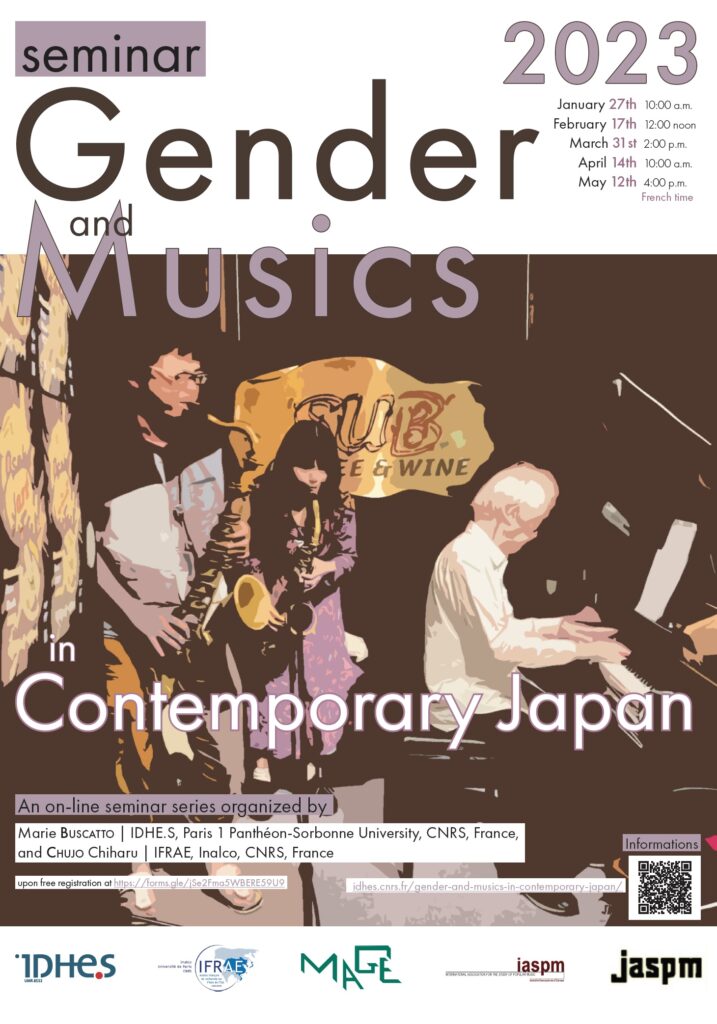Nous avons le plaisir de vous inviter à la troisième séance de notre série de séminaires Gender and Musics in Contemporary Japan.
Elle aura lieu en ligne le 31 mars (de 14h00 à 16h30, heure française).
Titre de la séance : « Gendered Strategies in the Underground Musical Scenes«
Discutant : Marc PERRENOUD (Université de Lausanne, Suisse)
« From Shonen Knife to Social Media: All-female Japanese Punk Rock Groups and the Global Marketing of Girls », Jennifer MILIOTO MATSUE (Union College, USA)
« Gender Strategies of Visual-kei Bands and the Transformation of Fandom », INOUE Takako (Daito Bunka University, Japan)
Ce séminaire se déroulera en ligne, en anglais, et pourra être suivi sur inscription gratuite à l’adresse https://forms.gle/jSe2Fma5WBERE59U9
Lien vers le programme complet.
« From Shonen Knife to Social Media: All-female Japanese Punk Rock Groups and the Global Marketing of Girls », Jennifer MILIOTO MATSUE (Union College, USA)
Formed in 1981, all-female Japanese punk group Shonen Knife continue to garner recognition as one of the most significant international Japanese recording artists in history, inspiring global fans to search for other Japanese punk groups, many comprising women (McCorkle Okazaki 2021). Indeed, in the late 1990s through ethnographic research on what I label as the Underground Tokyo Hardcore Scene (UTHS), I identified a particular style of hardcore performance as “onna no ko no bando” or “girl bands” (Milioto Matsue 2008). Either featuring all-female members or with strong female fronts, much as the “Riot Grrrl” movement and such valorized performers as Bikini Kill, these bands challenged common stereotypes of acceptable female social behavior through screaming vocals, thrashing guitars, and pounding percussion. Following the multiple waves of feminism in the West and the “Women’s Era” (“josei no jidai”) in Japan, which have increased pressures to create gender equity, one might expect these girls finally to have matured into “women.” However, a quick internet search reveals that Japanese female punk performers continue to be marketed as “girls,” a concept at once both infantilizing and empowering. This paper further explores this continued capitalization of “girl punk” today for English-speaking consumers, considering the ways in which this label is informed by global perceptions of Japanese masculinity and women’s roles in contemporary society.
« Gender Strategies of Visual-kei Bands and the Transformation of Fandom », INOUE Takako (Daito Bunka University, Japan)
About forty years have passed since X JAPAN, one of the most influential bands among the founders of visual-kei, appeared on the 1980s J-rock scene. Although visual-kei bands have almost disappeared from the mainstream popular music scene, the subculture of visual-kei has been established as one of the specific genres in the underground music scene. The conventional style of visual-kei bands from the perspective of music, visual image, and business have been still under influence of X JAPAN, further have been developed by his followers including the C21st neo-visual-kei. That is to say, the new category of male aesthetics extended by repossession of bodily representation confined in the female sphere, that I explored in my article “Constructing Male Aesthetics in Rock and Makeup: Gender Strategies by Musicians and Fans of Visual Rock in Japan” in Gender and Modernity: Perspective from Asia and the Pacific (Inoue 2003), is still applicable to today’s scene. Similarly, the visual-kei fandom today also seems to be no radical changes from that of the 1990s: cosplay for girls and ban-yaro (band wannabes) for boys among those of the C21st. However, the transformation can be found in the establishment of bangya (band gals) culture, for example, the way to involve in live concerts has been established and bangyas must follow this way. In this presentation, I will especially pay consideration to unchanged and conventional gender relations in a domesticated society even in the C21st, as the makeup regarded as a female sphere is still the most important factor to characterize Visual-kei, with band members being almost always boys, while its fans are girls to the contrary.

